Welcome to a new series that I’m calling “BitB Bits,” an irregular collection of random natural history observations recorded in my notes over the previous month. The individual snippets are, by themselves, too short for stand-alone posts, but I hope that readers will find their collective and chronological nature interesting and informative.
March 9. Welcome home walk. Good to be home and glad to see we didn’t miss the start of spring here. Non-native daffodils are blooming everywhere (I must admit they make an impressive display); however, we also have our first native blooming plant—spicebush (Lindera benzoin). Apparently only the male plants are blooming so far (distinguished by their flowers with stamens/anthers only but lacking a central pistil); the female plants should follow suit shortly.

March 12. Spring on hold. Now that spicebush is in bloom, a succession of flowering trees and shrubs should follow. Fragrant sumac (Rhus aromatica) would be the next to follow, but the rain of the last few days has put it on hold. The buds are swollen and ready, however, to burst forth on the next sunny day.
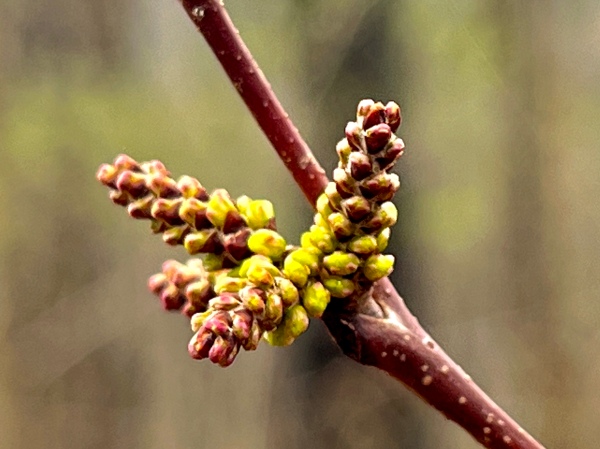
March 13. In my happy place. I didn’t get enough hiking at St. Francois State Park to satisfy my desires, so on the way back home I decided to stop off at Victoria Glades, one of my favorite places, and walk the perimeter of the main glade. I don’t think there’s another place on earth where I feel more connected to myself as a naturalist than here. I first visited way back in 1983 – the year after I moved to St. Louis after finishing grad school, and every year for the next eight years I came here once or twice per week throughout the summer to collect insects. I essentially “grew up“ here as an entomologist! In the time since moving back to St. Louis (now 27 years ago), I have resumed my regular visits – more in some years, less in others, and each time I do I feel rejuvenated. I have instructed Madam to sprinkle my ashes here (at least some of them) – if I depart and you happen to read this, please follow up with her to make sure that she does just that!
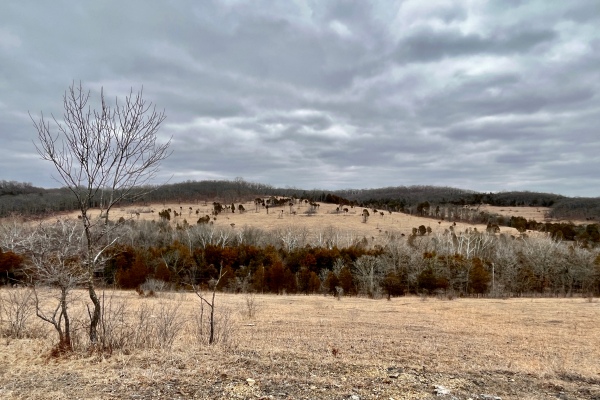
March 15. Beware the Ides of March. On this day, in 44 B.C., Julius Caesar was stabbed to death by a mob of Roman senators led by his friend Brutus. The senators believed that Julius had consolidated too much power (he had only a year earlier been named dictator for life and was implementing sweeping imperialist offensives in an effort to expand Roman territory), and that his death would lead to the restoration of the Republic. Sadly (or fortunately, depending upon your perspective), the “Ides of March” plunged Rome into centuries of civil war that ultimately led to utter collapse by the 5th century. In the final years of the empire, a series of emperors took the throne in quick succession (usually after the murder of their predecessor by the Praetorian Guard, the emperor’s personal bodyguards), each of whom plundered the state while they had the opportunity. The Roman Senate, engaged in their own corrupt practices and suffering from incompetence, was unable to curb the excesses of these emperors, leading to a waning of civic pride and loss of trust by the Roman citizenry before the final collapse.
March 17. C-c-cold! Once again, the bright sunshine was deceptive, belying how cold it really was – especially with that wind! Temps plummeted even further once the sun set, but the views around my home are still spectacular.
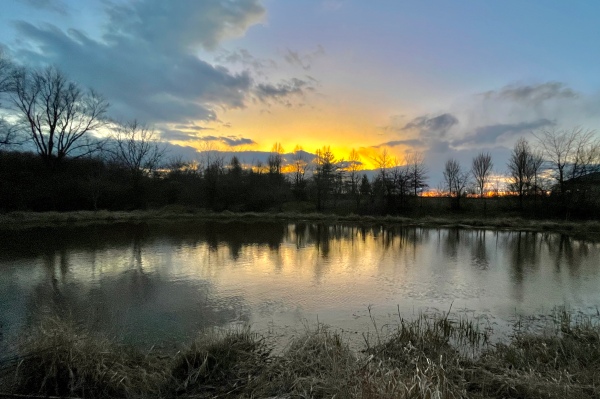
March 21. Still waiting… …for native blooms to begin. Until then, here is yet another non-native early bloomer—Scilla forbesii (Forbes’ glory-of-the-snow), which invaded the woods near my home after a neighbor planted some in their woodland garden. They are not nearly the problem that some other invasives are (like bush honeysuckle or burning bush) in that they don’t smother out nearby native plants, but they can provide a pollinating “sink” that competes for insects that would otherwise be pollinating the flowers of native plants.
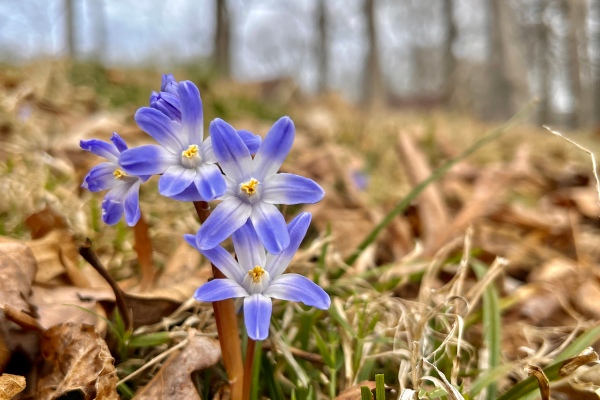
March 22. Vernal equiNOT. Spring began two days ago, yet I’m still waiting for the first appearance of any native wildflowers in the neighborhood. Until that happens, here is yet another non-native species—the thankfully noninvasive hyacinth—that my neighbor planted in their garden.
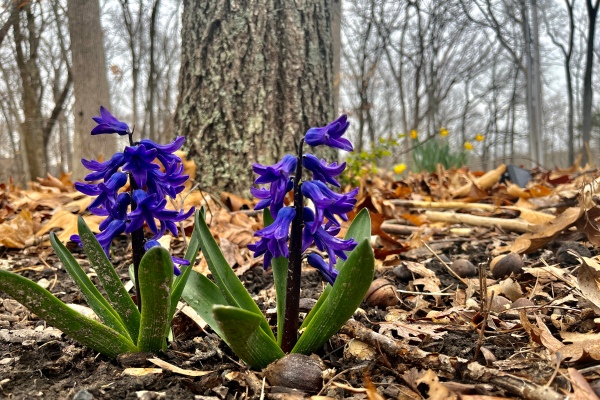
March 24. Spring at last, spring at last, thank God Almighty, spring at last! Finally, after sitting dormant for more than a week, the flowers of Rhus aromatica (fragrant sumac) have opened—in my opinion the true opening salvo of spring. Even so, it’s not like the weather suddenly turned spring-like, but more like the sumacs finally said F this and decided to open despite the continued dreary conditions.
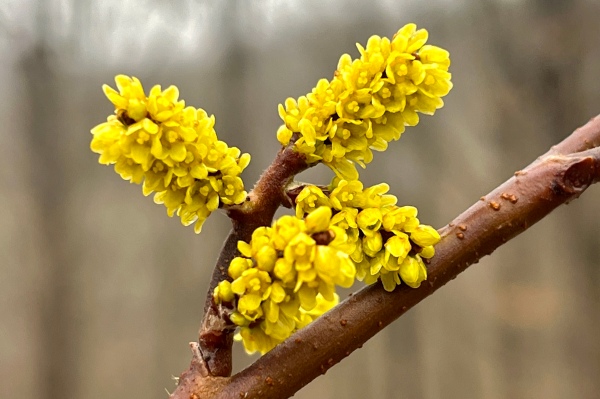
March 25. How do snail’s eyes differ from slug’s? They don’t—they’re both eye tentacles. 🥁

March 26. Spring beauty. Now that spring is truly here, Claytonia virrginica (spring beauty)—the icon of spring ephemeral wildflowers—has begun popping up everywhere.
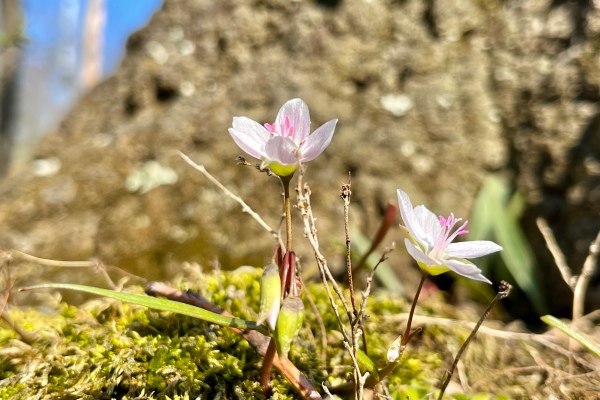
March 26. Water spider. I saw this large fly sitting on the curb. Of course, I knew it was a crane fly—a member of the family Tipulidae, but I hear people often confuse them for a “giant mosquito.” There is no such thing, and while I admit that they do look superficially like a mosquito on steroids (they happen to be distantly related to mosquitos), they do not bite or suck blood—arguably the most important part about being a mosquito. In fact, crane flies often do not eat anything once they become adults, with some species even lacking functional mouthparts. The family name is derived from the Latin word for “water spider,” perhaps because the larvae live in water and have a ring of tentacles around their head—just guessing. Anyway, I snapped a few pics of the little guy before he feebly began flapping his wings in the chilly air and took flight, probably looking for something to not eat.

March 28. Back to winter (midge). A few tantalizingly warm, sunny days had my hopes up that spring was finally here, but the return of cool, wet conditions have brought back that late winter feel. Perhaps appropriately, one of the first insects I’ve seen this season is this small, mosquito-looking fly that is actually a distant relative belonging to a group known as winter midges (genus Diamesa—also called snow midges—in the family Chironomidae). As their common names imply, the adult flies are seen active primarily during winter and can even be seen walking about on snow during warm spells during the winter (a scenario mimicked by the styrofoam on which this individual was photographed). Like the crane flies that I featured a couple days ago, winter midges do not feed as adults—if only for lack of suitable food sources, while the larvae feed on organic debris in cold, running water.

March 29. What’s up, buttercup? Buttercups are popping up in the “more natural“ lawns of my neighborhood. We have a number of species buttercups in Missouri – this one is Ranunculus harveyi (Harvey’s buttercup). In general, you can distinguish buttercups by their small, bright yellow flowers and bristle of anthers surrounding the central disc.
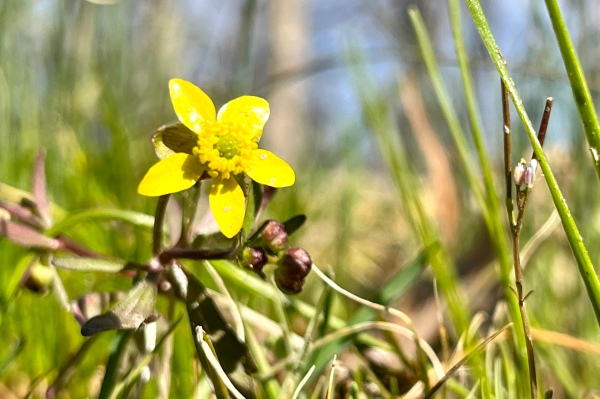
March 30. Bloodroot. I made a rather exciting wildflower find in the woodlands around my house this morning—a small patch of Sanguinaria canadensis (bloodroot) with (thus far) but a single bloom. This poppy relative (family Papaveraceae) is so named because of red, fleshy root, which gets its color from alkaloids, chiefly sanguinarine, in its toxic sap. First Americans traditionally used bloodroot to treat fever, rheumatism, ulcers, ringworm, and skin infections, and it is still used to produce natural red, orange, and pink dyes. There is likely some truth to the bioactive properties of bloodroot alkaloids, as they are currently being studied for use as anti-cancer agents, particularly for the treatment of skin cancer, and as a dissolving agent for skin growths such as warts. Bloodroot is also interesting from a natural history standpoint in that the seeds have fleshy appendages that are attractive to ants. The ants collect the seeds and bring them to their nest, thus effecting dispersal of the seeds. This is an advantage for these small plants growing in wooded habitats, where wind speeds are usually too low to aid natural seed dispersal.
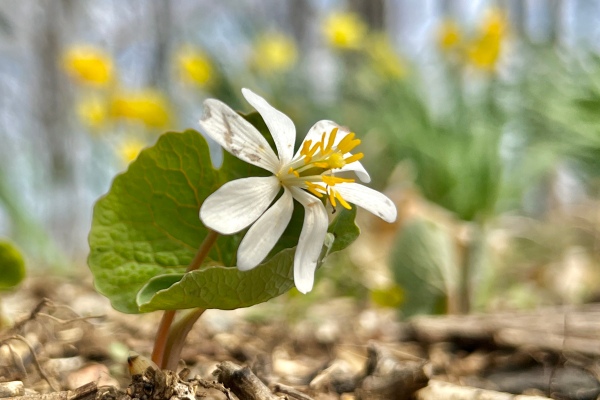
March 31. Sweet William. I saw these plants yesterday while their blooms were still closed and wondered if they would open before March closed out. I normally think of Phlox divaricata (sweet William) as a mid-April bloomer, but clearly it can begin earlier if conditions are right (as they have been the past several days).
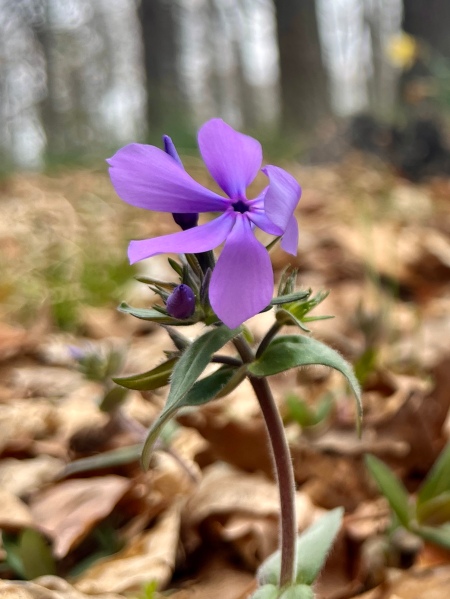
©️ Ted C. MacRae 2023